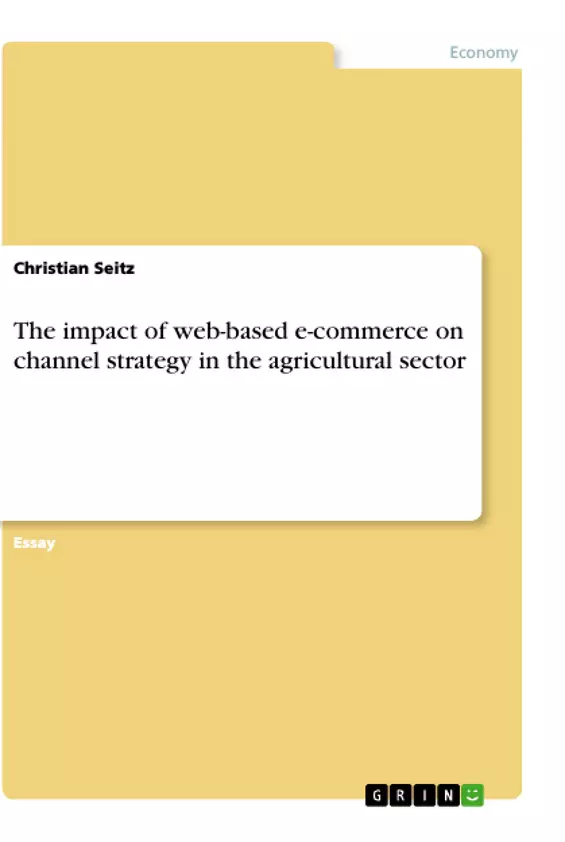Over the past decade, no other medium has changed our current lifestyle or the way we conduct business more than the emergence of the internet since the invention of television. The Internet enables firms and companies to do business on a more advanced level. Now it is possible to shorten distances even further, enhance the ability to communicate and transact across geographical boundaries and thereby reduce or eliminate transaction costs. Since the internet already represents a new infrastructure, it has a strong impact on business organizations. The importance of web-based distribution channels has rapidly surged and web-based distribution channels have become an integral part of the channel strategy of businesses across the globe. Transactions like buying, selling, delivering or contracting seem to be potential incentives for a conversion to e-commerce.
The following three factors: (1) industry structure, (2) product complexity, and (3) the complex nature of business processes within the firm, play a crucial role when it comes to e-commerce in the agricultural sector. The main objective of this paper is to analyze these dominant factors in order to find out in what ways web-based e-commerce is affecting the channel strategy in the agricultural business. At first, the paper will give a short literature review in which the most important terms will be defined. Second, the role of distribution channels will be discussed in order to develop an understanding of how important the channel selection decision is. Third, the channel strategy of web-based e-commerce and its potential benefits will be illustrated. The fourth chapter analyses the three dominant factors that have an impact on the adoption of web-based e-commerce in the agricultural sector. Finally, in the fifth chapter, based on the preceding chapters, the strategic implications for agribusinesses will be drawn. A conclusion will bring this paper to an end.
Inhaltsverzeichnis (Table of Contents)
- Introduction
- Material and Methods
- Results and Discussion
- Literature Review
- Agricultural Marketing
- Web-based E-commerce
- The Application of Web-based E-commerce in Agriculture
- The Role of Distribution Channels
- The Importance of Distribution Channels as Part of Infrastructure
- The Selection Decision of Distribution Channels
- The Channel Strategy of Web-based E-commerce
- The Development of Web-based E-commerce
- Literature Review
Zielsetzung und Themenschwerpunkte (Objectives and Key Themes)
This paper examines the impact of web-based e-commerce on channel strategy in the agricultural sector. The primary goal is to understand how factors such as industry structure, product complexity, and business process complexity influence the adoption of e-commerce in agribusiness.
- The role of distribution channels in agricultural markets and the importance of channel selection.
- The development and potential benefits of web-based e-commerce strategies in agribusiness.
- The influence of industry structure, product complexity, and business process complexity on e-commerce adoption in agriculture.
- The strategic implications of web-based e-commerce for agribusinesses.
Zusammenfassung der Kapitel (Chapter Summaries)
The paper begins with a literature review, defining key terms such as agricultural marketing, agribusiness, and web-based e-commerce. It explores the evolution of e-commerce and its application in the agricultural sector, highlighting the specific challenges and opportunities presented by the online trading of agricultural products.
The next section examines the crucial role of distribution channels in agricultural markets. It discusses the importance of efficient infrastructure, such as transportation and communication systems, in facilitating market operations. The chapter also explores various channels of distribution for agricultural products, emphasizing the importance of channel selection for cost optimization and consumer satisfaction.
The paper then delves into the channel strategy of web-based e-commerce, tracing its development from the advent of telephone and telefax to the emergence of the internet and the personal computer. It highlights the impact of these technological advancements on business practices and the increasing reliance on online communication and information sharing.
Schlüsselwörter (Keywords)
The primary focus of this paper lies on the interplay between e-commerce, distribution channels, and the agricultural sector. Key terms include e-commerce, distribution channels, agribusiness, and e-agribusiness. The study explores the impact of industry structure, product complexity, and business process complexity on the adoption of web-based e-commerce strategies in the agricultural sector.
- Citation du texte
- Christian Seitz (Auteur), 2012, The impact of web-based e-commerce on channel strategy in the agricultural sector, Munich, GRIN Verlag, https://www.grin.com/document/209114



